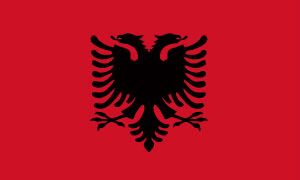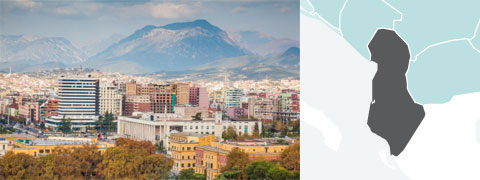Country assessments
Albania
- Details
- Country assessments
2013 sector transition indicators
Source: EBRD.
Note: Water – Water and wastewater; IAOFS – Insurance and other financial services; PE – Private equity.
Highlights
- The economy has slowed considerably over the past year. GDP grew by only 1.6 per cent in 2012, notably lower than in recent years, when the economy generally expanded by over 3 per cent annually. The weak performance, which is, to a large extent, due to external developments, has continued into 2013.
- Progress on the key remaining privatisations has been mixed. The sale of the four hydropower plants – Ulez, Shkopet, Bistrica 1 and Bistrica 2 – was completed in early 2013, after previous failed attempts. However, the privatisation of the oil company, Albpetrol, was cancelled because of tender irregularities.
- Albania’s European Union (EU) membership aspirations received a boost in 2013. The European Commission has recommended that Albania be granted EU candidate status, on the condition that it continues to fight corruption and organised crime.
Key priorities for 2014
- Fiscal adjustment is needed. The budget deficit more than doubled in the first half of 2013. Measures to stem the rise of public debt, including the restoration of a fiscal anchor, should be implemented next year.
- Privatisation needs to continue, and the dispute with the Czech-owned distribution company, CEZ, should be resolved as soon as possible. The protracted dispute is having an adverse impact on foreign investor confidence, both in the sector and more broadly in the economy.
- Measures should be taken to address the high and rising level of non-performing loans (NPLs) in the financial sector. NPLs have risen to nearly 25 per cent of total loans, threatening the overall stability of the sector.
Macroeconomic performance
Economic activity has been weakening through 2012 and the first months of 2013. In 2012 GDP grew by only 1.6 per cent, which was considerably lower than previous years, when output increased by more than 3 per cent annually. The subdued economic performance has continued into 2013, and GDP grew by 1.7 per cent in the first quarter. This weak growth performance reflects the extent of difficulties in the eurozone, particularly in periphery countries that are Albania’s major economic partners. Cross-border parent bank deleveraging has been significant.
Inflation has moderated and, thanks in part to the Bank of Albania’s (the central bank) successful inflation targeting framework, remains under control. In January 2012 inflation fell below the target range of 2-4 per cent. With concerns mounting over weakening economic growth, the central bank began a series of cuts in the base interest rate this year, with the latest – in July 2013 – bringing down the interest rate to a historical low of 3.5 per cent. Inflation declined to 1.6 per cent year-on-year in July 2013.
The fiscal deficit rose substantially due mainly to a pre-election spending hike. The reported deficit more than doubled in the first half of 2013, rising to 3.4 per cent of the projected 2013 GDP (from 1.6 per cent of GDP in 2012). In 2012 public debt reached the statutory limit of 60 per cent of GDP, and legislation was passed in 2013 to remove this limit to accommodate a further expected rise in public debt. The hike in the deficit will contribute to a further rise in public debt. The International Monetary Fund has urged the government to reinstate a fiscal anchor and thus commit to bringing down public debt to a more sustainable level. In the meantime, the government has introduced a set of expenditure-related restrictions to prevent a further rise in the deficit this year.
The outlook for 2013 remains clouded by the economic difficulties in the eurozone. Moreover, the downside risks are high, as macroeconomic imbalances persist and the financial sector continues to be exposed to both domestic and external risks, while the macroeconomic policy buffers have been exhausted. Over the medium term Albania could benefit considerably from a global recovery if it is to be able to make further progress on much-needed structural reforms.
Major structural reform developments
The receipt of EU candidate status remains uncertain. In October 2012 the European Commission recommended that Albania be granted the status of EU candidate country, conditional upon the completion of certain measures in the areas of judicial reform and public administration. In December 2012 the Council of the EU stressed the need for further reforms, and invited the European Commission to report back to it as soon as it considers that necessary progress has been achieved. The generally peaceful June 2013 parliamentary elections resulted in an orderly and timely transition to a new government, and in October 2013 the Commission recommended the granting of EU candidate status to Albania, conditional upon the authorities continuing the fight against corruption and organised crime. The EU Council’s decision about Albania’s candidate status is due in December 2013.
Developments have been mixed on the privatisation front. In April 2013 the government was finally able to complete the sale of the four hydropower plants – Ulez, Shkopet, Bistrica 1 and Bistrica 2 – which were spun off from the state-owned power utility, KESH. They were sold to steelmaker Kurum International, a subsidiary of a Turkish holding company, following approval from the state competition authority. However, the privatisation of the state-owned oil company, Albpetrol, was cancelled in February 2013, after the winning bidder failed to make the required initial payment. The government has launched a probe into the failed privatisation on suspicion of violations of tender procedures. Similarly, the sale of the oil refinery, ARMO, to the same bidder was invalidated by the competition authority.
The dispute between CEZ and the Albanian government has damaged investor confidence in the power sector. In January 2013 the energy regulator decided to strip the Czech distribution company, CEZ, of its licence to operate in Albania, blaming the company for the severe electricity and water shortages in several regions. CEZ had argued that it had to cut the supply of power and water to these regions because of unpaid bills. The company also claimed that it was forced to operate at a loss amid high electricity import costs and low regulated power prices for Albanian consumers. The Czech company launched arbitration proceedings against Albania in May 2013. This dispute has heightened investor concerns regarding engagement in Albania’s power sector. Austria’s energy group, EVN, which has many operations in the south-eastern Europe (SEE) region, decided to withdraw from a €950 million project in Albania by selling its stake to its Norwegian partner, Statkraft. The two companies had won a concession to build three hydropower plants on the Devoll River in 2009. Difficulties in the power sector have been reflected in the EBRD’s downgrade of the sector’s transition gap assessment.
Improvements in the regulatory framework of the roads sector have been introduced. The General Roads Directorate has been recently transformed into the Albanian Road Authority (ARA), an autonomous roads agency. The draft Service Level Agreement (SLA), introducing a more commercial arrangement for the provision of road administration, has been prepared and awaits adoption. The ARA will, among other things, oversee the contracting of road maintenance works to private sector contractors.
Limited progress has been made in improvements to the business environment over the past year. Only a few notable improvements have been made since a big push on reforms was made between 2009 and 2010, when the regulatory requirements for starting a business were reduced considerably. As a result, Albania continues to rank below most regional peers on the indicators of the quality of its business environment. In the World Bank 2014 Doing Business report, Albania’s ranking improved on just one indicator, while remaining constant or declining on all others. Its overall standing relative to other countries declined by eight positions, to ninetieth of 189 countries. The country continues to perform most poorly in dealing with construction permits, paying taxes, getting electricity and registering property. In the latest World Economic Forum Global Competitiveness Index, Albania ranked ninety-fifth of 148 countries. The report points to considerable underperformance with regard to property rights and judicial independence. Corruption is another major deterrent for new investment. In the latest Transparency International Corruption Perceptions Index, Albania ranked one hundred and thirteenth of 176 countries, and below all other SEE countries.
The financial sector is burdened by a very high level of NPLs, weakening credit demand, and significant parent bank deleveraging. The level of NPLs has risen to more than 24 per cent of total loans, despite a number of new measures that were introduced by the central bank in 2012 to encourage earlier loan restructuring. The rise in NPLs – 57 per cent of which are provisioned for, as of mid-2013 – has resulted in banks’ tightening lending conditions for corporates and households over the past year. Credit growth has also declined considerably over the past year, standing in April at only 0.15 per cent year-on-year, which likely reflects weak demand for credit in the slowing economy.













